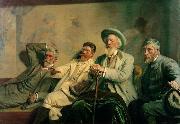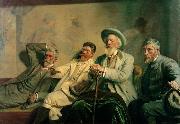Wholesale Oil Painting No Minimum |
|||||||||||
|
|
|||||||||||

|
|||||||||||
|
|
|
||||||||
Michael AncherDanish Painter, 1849-1927 He studied at the Kongelige Akademi for de Sk?nne Kunster, Copenhagen (1871-5), where his teachers Wilhelm Marstrand and Frederik Vermehren encouraged his interest in genre painting. He first visited Skagen in 1874 and settled there in 1880, having found that subject-matter drawn from local scenery was conducive to his artistic temperament. In Will he Manage to Weather the Point? (1880; Copenhagen, Kon. Saml.) several fishermen stand on the shore, evidently watching a boat come in. The firmly handled composition focuses on the group of men (the boat itself is invisible); each figure is an individual portrait that captures a response to the moment. Ancher's skill at grouping large numbers of figures with heroic monumentality compensates for his lacklustre colour sense. A change in his use of colour is noticeable in the works produced after an influential visit to Vienna in 1882; he was deeply impressed by the Dutch Old Masters at the Kunsthistorisches Museum, especially the Vermeers. Their effect on his painting can be seen in the Sick Girl (1883), |
||||||||
|
|
||||||||
Art Judges
Art Judges Painting ID:: 70332 |
1906(1906)
Oil on canvas
1906(1906) Oil on canvas |
|||||||
|
|
||||||||
Anna AncherDanish Painter, 1859-1935 was the only one of the Skagen Painters that was actually born in Skagen, Denmark. Anna Ancher was born and grew up in the northernmost area of Jutland, called Skagen (the Skaw). Her talent became obvious at an early age and she grew acquainted with pictorial art via the many artists who settled to paint in Skagen. Anna Ancher studied drawing for 3 years at the Vilhelm Kyhn College of Painting in Copenhagen. However, Anna Ancher developed her own style and was a pioneer in observing the interplay of different colours in natural light. She also studied drawing in Paris at the atelier of Pierre Puvis de Chavannes along with Marie Triepcke, who would marry Peder Severin Krøyer, another Skagen painter. In 1880 she married fellow painter Michael Ancher, whom she met in Skagen. They had one daughter, Helga Ancher. Despite pressure from society that married women should devote themselves to household duties, she continued painting after marriage. Anna Ancher is considered to be one of the great Danish pictorial artists by virtue of her abilities as a character painter and colourist[citation needed]. Anna Ancher's art found its expression in Nordic art's modern breakthrough towards a more truthful depiction of reality, e.g. in Blue Ane (1882) and The Girl in the Kitchen (1883-1886). Anna Ancher preferred to paint interiors and simple themes from the everyday lives of the Skagen people and fishermen, |
||||||||
|
|
||||||||
|
|
Art Judges
Art Judges Painting ID:: 85212 |
1906(1906)
Medium Oil on canvas
cyf 1906(1906) Medium Oil on canvas cyf |
||||||
|
|
||||||||
|
Anna Ancher Danish Painter, 1859-1935 was the only one of the Skagen Painters that was actually born in Skagen, Denmark. Anna Ancher was born and grew up in the northernmost area of Jutland, called Skagen (the Skaw). Her talent became obvious at an early age and she grew acquainted with pictorial art via the many artists who settled to paint in Skagen. Anna Ancher studied drawing for 3 years at the Vilhelm Kyhn College of Painting in Copenhagen. However, Anna Ancher developed her own style and was a pioneer in observing the interplay of different colours in natural light. She also studied drawing in Paris at the atelier of Pierre Puvis de Chavannes along with Marie Triepcke, who would marry Peder Severin Krøyer, another Skagen painter. In 1880 she married fellow painter Michael Ancher, whom she met in Skagen. They had one daughter, Helga Ancher. Despite pressure from society that married women should devote themselves to household duties, she continued painting after marriage. Anna Ancher is considered to be one of the great Danish pictorial artists by virtue of her abilities as a character painter and colourist[citation needed]. Anna Ancher's art found its expression in Nordic art's modern breakthrough towards a more truthful depiction of reality, e.g. in Blue Ane (1882) and The Girl in the Kitchen (1883-1886). Anna Ancher preferred to paint interiors and simple themes from the everyday lives of the Skagen people and fishermen, Art Judges 1906(1906) Medium Oil on canvas cyf |
||||||||
|
|
||||||||
|
Prev Next
|
||||||||
|
|
||||||||
|
Related Paintings to Anna Ancher :. |
||||||||
|
|
||||||||
|
CONTACT US |


